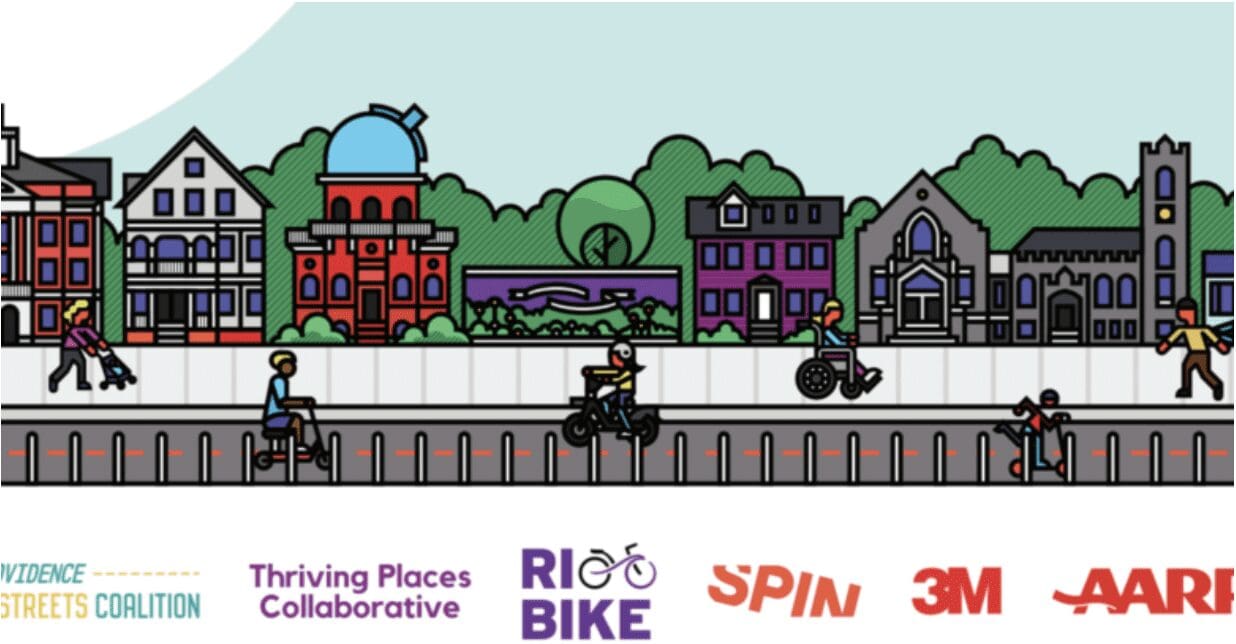Search Posts
Recent Posts
- Dr. Rosemary Costigan Named President of Community College of Rhode Island June 19, 2025
- RI Veterans: Did you know? 19.06.25 (Military Funerals, Job Fair, Benefits, Events) – John A. Cianci June 19, 2025
- East Providence First in U.S. to Equip All Firefighters with PFAS-free Gear June 19, 2025
- We Cook! Mill’s Tavern Saffron Bouillabaisse with Tarhana Lobster Jus June 19, 2025
- Rhode Island Weather for June 19, 2025 – Jack Donnelly June 19, 2025
Categories
Subscribe!
Thanks for subscribing! Please check your email for further instructions.

Hope Street Bike Trail trial. Safety is not its purpose – David Brussat
by David Brussat, Architecture Here and There – contributing writer
For a week concluding tomorrow, Hope Street between Olney and Lauriston, that is, from Tortilla Flats to the Frog & Toad, has participated in a temporary “urban trail” experiment to see how the street and its denizens feel about an official bike path being laid down, regulating what has always been a free-form personal transportation alternative – much like our personal motor cars but to a more limited extent.
Thus far it seems not to be going down all that well.
Businesses dislike losing parking spaces. All are eliminated on the east side of the street. Drivers pushed by the trial’s parking ban to spots on side streets no doubt irk the residents on those streets.
Cyclists may not like how narrow the bike lanes are. The bike path has two lanes with yellow plastic bollards marking it off from the street, with occasional bollards marking the two bike travel lanes, which are also painted. Green stripes warn bikers of cross streets, and the lanes probably strengthen the feeling that traffic signals must be obeyed, whatever the normal attitude may be. Bikers traveling north must watch for sewer grates that reach midway into their lane. Occasional bus-stop risers and other obstructions also make the ride bumpier and the bollards allow less maneuvering room to avoid obstacles. Is it fair to wonder whether raised “speed” bumps might be planned for the future, if the temporary bike path becomes permanent? Who knows what “add-ons” a permanent bike path on Hope might inspire.
A resident of Hope Village, near the stretch of shops and restaurants between Rochambeau Avenue and Fourth Street, wrote a day or two ago on Nextdoor, an online site for neighborhood news, that, in regard to this experiment, “Hope St is booming tonight! Restaurants full. The sky hasn’t fallen. As Aaron Rogers says R-E-L-A-X. No one is coming for the cars.”
That may place too much credit on the bike path, ignoring the dulcet weather of the past few days. Balancing that remark, also from Hope Village, is this one: the lanes are “too narrow. And they want pedestrians to share it? No goody. … The number of people who will switch from cars to bikes because of this ill-conceived path is minuscule.”
It is difficult, at this point, to judge the feelings aroused by this experiment. No doubt an official summary of expressed opinion will be released by its sponsors, including those beneath the pleasing promotional illustration atop this post.
Someone mentioned that bike paths increase riders’ safety by some 30 percent. Maybe that is so, but it is likely that safety is not the purpose of this bike path or of the system of paths growing like kudzu across Rhode Island and elsewhere.
It is, rather, as the second commenter suggested, that bicycling is indeed seen as a strategy for getting more cars off streets to reduce the carbon footprint. Or at least one of many strategies designed to help us imagine that a “transition” is indeed taking place from fossil fuels to renewable energy.
A bicycle, however, may be rightly perceived as an instrument of freedom akin to the way cars have been for more than a century. But that is no longer convenient. In order to change social behavior – such as moving people from gas-guzzling cars to bicycles – bureaucrats often assume society must reverse its conventional practices. People must be enabled, if not coerced, into preferring an officially sanctioned behavior, such as using bike paths instead of free-range pedaling along neighborhood streets. Users of bike paths give some people a manufactured sense of “doing the right thing,” and others a feeling of being able to look down their nose at people in automobiles, who can be disagreeably enviable.
But enough armchair psychology. A massive switch to the use of bicycles for commuting won’t shrink America’s carbon footprint by any significant degree.
Instead, bicycling is good because it is fun. I used to bike for that reason years ago. Cyclists who commute from the East Side to downtown (or between any two other points) will probably have more fun and be safer if they avoid Hope Street, or other major thoroughfares, and instead use the networks of streets through which major avenues like Hope pass.
For example, Lorimer Street and Morris Avenue parallel Hope to the east and form an easy way between several blocks north of Lauriston to a block south of Olney. The traffic is very light, and at times virtually nonexistent. Then you can bike through College Hill along any number of historical and beautiful streets, then head into downtown on College Street. You can pay more attention to the delights of a neighborhood – squirrels, birds, dogwalkers, pretty girls, etc. – and not have to keep your eyes quite as well peeled on potential dangers.
I can’t quite figure out whether the Hope Street trail trial is meant to grease the skids for a permanent bike path, demonstrating a fake concern for the opinion of Hope Street merchants and residents. Or whether it is designed to show such a concern for the opposite reason, with the possibility of a permanent bike path on Hope already considered a nonstarter by local authorities, who no doubt feel they have already done their part in the fight for the Green New Deal. No city money has been budgeted for a permanent Hope Street bike path, it is said, but these days federal dollars will always be knocking on the door.
Either way, it’s nice that the opinion of we lowly citizens has been solicited on this very important issue.
___
To read other articles by David Brussat: https://rinewstoday.com/david-brussat-contributing-writer/

My freelance writing and editing on architecture and others addresses issues of design and culture locally and globally. I am a member of the board of the New England chapter of the Institute of Classical Architecture & Art, which bestowed an Arthur Ross Award on me in 2002. I work from Providence, R.I., where I live with my wife Victoria, my son Billy and our cat, Gato. If you would like to employ my writing and editing to improve your work, please email me at my consultancy, dbrussat@gmail.com, or call (401) 351-0451

I was in the area the other day to do an errand and this is my observation. I am handicapped. There was no accommodation for me. Also, what about fire and rescue? If there was a problem, they have no access. I get the biking thing but it’s not for everywhere. Want to bike then go to a bike path where tax payers have spent millions